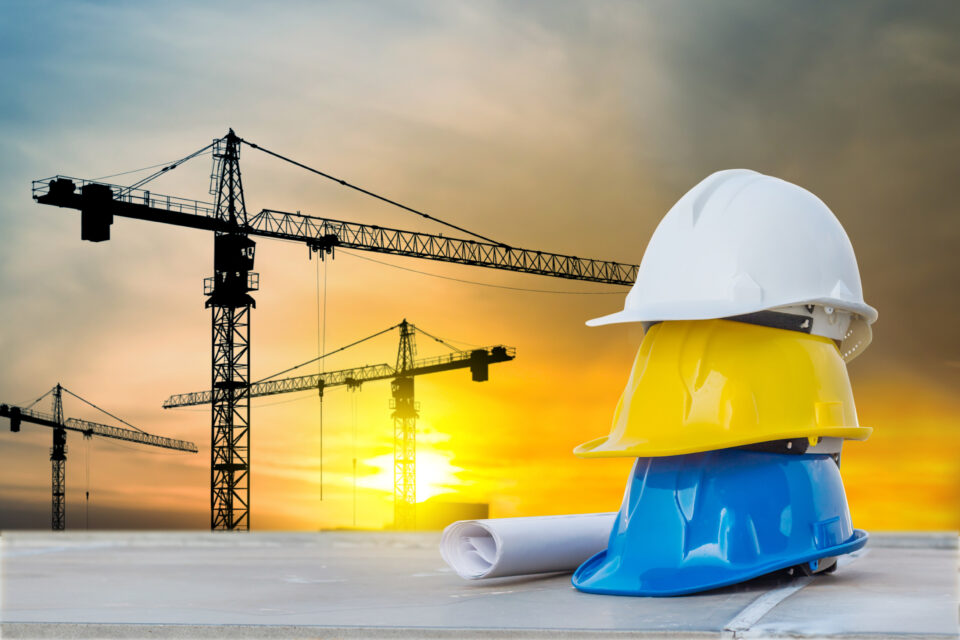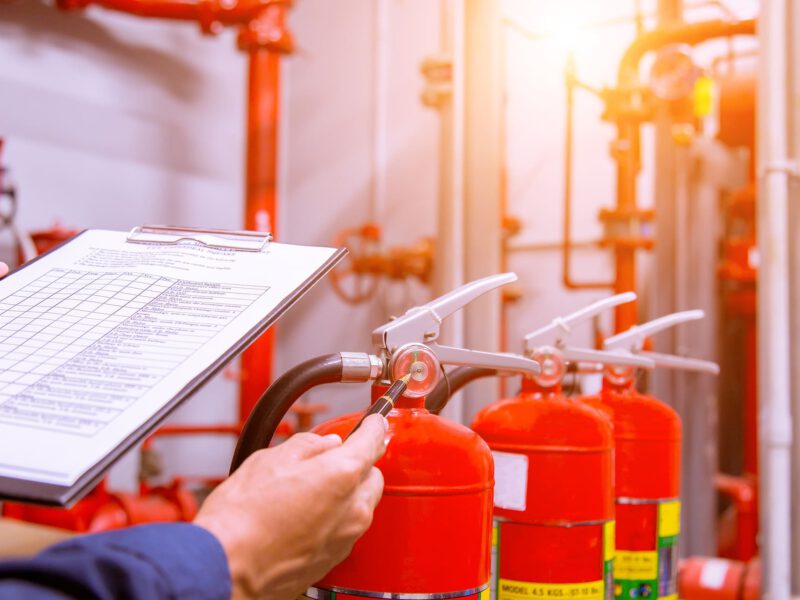
Construction site safety – occupational health and safety on construction sites
Construction site safety: protection against hazards and risks
Working on construction sites always involves particular hazards and risks. Employees on construction sites are not only exposed to high physical stress, but often work at extreme heights or in adverse weather conditions. Handling heavy machinery and hazardous building materials also poses a considerable risk of accidents. Uninvolved persons such as passers-by, children or construction site visitors are also exposed to potential dangers at adjacent construction sites. Therefore, no company should neglect safety aspects on construction sites.
Responsibility for occupational safety on construction sites
Occupational health and safety on construction sites is primarily the responsibility of the contractors. Managers with authority to issue instructions, such as site managers, foremen and supervisors, are responsible for giving clear instructions to employees, conducting regular training and ensuring that the risk assessment is always up to date.
Our services for your construction site safety
As experienced experts in construction site safety, we offer comprehensive safety support for construction companies, building owners, architects and specialist planners. Our services include:
- Preparation of risk assessments and operating instructions:
We support you in preparing important documents for safety on construction sites. - Conducting training sessions:
We organise and conduct regular training sessions to ensure the safety of your employees. - Preparation of rescue concepts:
We help you plan and implement rescue measures. - Consulting on structural occupational safety:
We prepare expert opinions on safety requirements on construction sites. - Compliance with workplace regulations and technical rules (ASR):
We advise you on legal requirements and ensure that you comply with them. - Safety support from experienced specialists:
Our safety specialists have extensive experience in construction site practice. - Advice on occupational safety organisation:
We support you in setting up an effective safety organisation. - Creation of project-specific safety documents:
From safety concepts for roof work to demolition instructions – we deliver tailor-made solutions. - Fire safety organisation on construction sites:
We help you create escape and rescue plans, fire brigade plans, alarm plans and welding permits. - Coordination and design of approval and permit procedures:
We optimise your safety processes and adapt existing procedures.
Occupational Safety Management System (AMS BAU) – Sustainable occupational safety and health protection
The Occupational Safety Management System (AMS BAU) from BG BAU is a comprehensive and sustainable management system that ensures the holistic integration of occupational safety and health protection in your company. With AMS BAU, you can ensure that your business meets all legal requirements while improving the safety and well-being of your employees.
Our support for your AMS BAU certification
HSE-Ingenieure GmbH offers you expert support in introducing or maintaining your AMS BAU system. Our services include:
- Actual analysis of safety and health protection requirements:
We conduct a detailed analysis of your current workplaces and their requirements with regard to occupational safety and health protection. - Target concept:
Taking into account all AMS BAU specifications, we develop a concept tailored to the specific needs of your company. - Support with the introduction of the management system:
We help you with the introduction of AMS BAU, including the creation of customised working documents for your AMS certification. - Support with BG-Bau certification:
We guide you through the entire certification process and ensure that all requirements are met. - Ongoing support with audits:
Even after certification, we are there to assist you with future AMS audits and support you in your ongoing optimisation efforts.
Your advantages with AMS BAU
Implementing AMS BAU offers you numerous advantages. Not only do you meet the strict requirements of customers, suppliers and employees, you also strengthen your legal security. In addition, successful AMS BAU certification automatically improves your image, which may give you preferential consideration in tendering procedures by clients.
Safety and health protection coordinator (SiGeKo) in accordance with the Construction Site Ordinance
In accordance with the Construction Site Ordinance (BaustellV), the client or a third party commissioned by them is obliged under Section 4 to appoint a safety and health protection coordinator (SiGeKo) as soon as several employers are working on a construction site. This obligation serves to ensure compliance with safety standards and health protection throughout the entire construction phase.
Tasks of the safety and health protection coordinator
The tasks of the SiGeKo are set out in Section 3 of the Construction Site Ordinance in conjunction with RAB 30, which specifies the tasks in detail. These include, among other things, supporting the client and all parties involved in the construction project in integrating safety and health protection measures. This applies to both the planning phase and the execution of the construction project.
Through their work, SiGeKos help to ensure that construction processes are safe and efficient and that future work on the property is carried out in accordance with safety regulations.
Our support from experienced SiGeKos
At HSE-Ingenieure GmbH, we provide you with experienced and highly trained safety and health coordinators (SiGeKos). Our experts ensure that all requirements of the Construction Site Ordinance are implemented in a legally compliant manner and support you throughout the entire construction process.
Our SiGeKos help you to meet legal requirements while creating a safe working environment for everyone involved. If you need support in this area, please feel free to contact us at any time.
Advance notification of a construction site in accordance with § 2 BaustellV
As soon as work on a construction site is expected to last longer than 30 days and more than 20 people are employed at the same time, or the scope of the activities exceeds 500 person-days, the client or a third party commissioned by him is obliged to submit an advance notification to the competent authority. This must be done at least two weeks before the construction site is set up, in accordance with Section 2 of the Construction Site Ordinance (BaustellV).
Requirements for advance notice
The advance notice must be displayed visibly on the construction site and adjusted accordingly in the event of significant changes. It serves to ensure transparency and safety on the construction site. The following information must be included in the advance notice:
- Location of the construction site
- Name and address of the client
- Type of construction project
- Name and address of the responsible third party (if applicable)
- Name and address of the safety and health protection coordinator (SiGeKo)
- Expected start date and duration of the work
- Expected maximum number of employees on the construction site
- Number of employers and contractors without employees
- Details of the employers and contractors without employees already selected
Why is advance notification important?
Advance notification is a key component of construction site safety and serves to provide the competent authorities with an overview of the planned work and the companies involved. This helps to ensure that all legal requirements for occupational health and safety are met. Failure to comply may result in legal consequences for the client or the commissioned third party.
If you need assistance in this area, please feel free to contact us at any time.
Safety and health protection plan (SiGe plan) in accordance with Section 2 of the Construction Site Ordinance (BaustellV)
For construction sites where employees from several employers are working or where particularly hazardous work is being carried out, a safety and health protection plan (SiGe plan) is required in accordance with Section 2 of the Construction Site Ordinance (BaustellV). This plan ensures that all necessary safety measures for the construction site are defined and implemented.
The specific design of the SiGe Plan is described in RAB 31 (Regulations on Occupational Safety on Construction Sites). The SiGe Plan must be drawn up during the planning phase of the construction project and continuously updated throughout the entire construction phase in order to adapt to changing conditions on the construction site.
Contents of the safety and health protection plan (SiGe plan)
The SiGe plan is a key tool for ensuring occupational safety on construction sites. It includes the following points, among others:
- Work processes:
Detailed description of the planned work processes. - Risk assessments:
Identification of potential hazards that may arise during individual tasks. - Safety measures:
Definition of measures to avoid or minimise the identified hazards. - Spatial and temporal allocation:
Planning of work processes in terms of location and time to ensure that no dangerous overlaps occur. - Occupational safety regulations:
Compliance with all legal provisions on occupational safety to ensure the safety of employees.
Why is the SiGe plan important?
The SiGe plan plays a key role in ensuring that everyone involved on the construction site can work safely and securely. By incorporating it into the planning phase at an early stage and continuously adapting it during construction, the risk of accidents is minimised and compliance with statutory occupational health and safety regulations is guaranteed. For builders and clients, this means legally compliant implementation of the construction site ordinance and smooth running of the construction project.
If you need assistance in drawing up the SiGe plan, please feel free to contact us at any time.
Construction site regulations – improving safety and cooperation on construction sites
Construction site regulations support communication, coordination and cooperation between all parties involved on a construction site. They serve to optimise work processes while increasing safety for everyone working on the site. The client sets out general requirements in the construction site regulations that govern the behaviour and cooperation of companies, their employees, suppliers and visitors to the construction site.
Important aspects of construction site regulations
Well-structured construction site regulations remind all parties involved to comply with specific rules that are necessary to ensure safety and proper procedures. The essential contents of construction site regulations include:
- Rules of conduct for all employees on the construction site
- Safety regulations to prevent accidents and hazards
- Coordination between different trades and companies
- Access controls and regulations for suppliers and visitors
- Compliance with laws, standards and guidelines
Our support in creating construction site regulations
We at HSE-Ingenieure GmbH offer comprehensive support in creating and updating construction site regulations. We pay particular attention to compliance with all legal requirements such as laws, standards and guidelines. With our help, the construction site regulations become a valuable tool that not only improves cooperation but also contributes to compliance with all occupational safety regulations and increases safety on your construction site.
If you need support in creating and updating construction site regulations, please feel free to contact us at any time.
Documentation for future work in accordance with the Construction Site Ordinance
In accordance with the Construction Site Ordinance (BaustellV), documentation must be created for future work that contains all safety and health protection information that must be taken into account during future work on the building structure. RAB 32 specifies the requirements for this documentation.
The main purpose of the documentation is to ensure that future work, such as façade cleaning, maintenance of technical systems and other maintenance work, is carried out in a manner that is safe and healthy. This enables long-term and economical use and maintenance of the building. It is important to note that the employer’s obligation to comply with occupational health and safety regulations remains unaffected even in the case of subsequent work.
Advantages of the documentation for future work
The creation of such documentation has numerous advantages:
- Safety-conscious planning:
Future work can be planned and carried out taking into account all relevant safety and health protection requirements. - Long-term efficiency:
Early planning contributes to the economical use and maintenance of the plant. - Legal certainty:
The documentation supports compliance with legal requirements and minimises the risk of accidents at work. - Protection of employees:
The safety and health precautions ensure that future work can be carried out safely.
Support from HSE-Ingenieure GmbH
We at HSE-Ingenieure GmbH support you in creating and updating documentation for future work in accordance with the requirements of the Construction Site Ordinance and RAB 32. With our expertise, we ensure that your building complies with legal requirements and that future work can be planned safely and efficiently.
Risk assessment and safety concepts for areas at risk of falling
As part of the risk assessment, it is important to identify and define the measures required to protect employees. Specific protective measures must be taken to prevent accidents, especially in areas at risk of falling. This also includes planning rescue measures for rescue from heights and depths. The employer is obliged to define these measures independently with the support of the company doctor and the occupational safety specialist.
Our support in the creation of safety concepts
We at HSE-Ingenieure GmbH support you in the creation and updating of a practical safety concept for areas at risk of falling. In doing so, we pay particular attention to compliance with all legal requirements such as laws, standards and guidelines. Our goal is to develop tailor-made solutions for your company that meet the requirements of the risk assessment and ensure maximum safety.
What we offer:
- Analysis of areas at risk of falling:
We carry out a detailed risk assessment to identify risks and determine appropriate protective measures. - Practical safety concepts:
Our safety concepts are practical and take into account the specific conditions of your construction site or facility. - Legally compliant solutions:
We ensure that all legal requirements, standards and guidelines are complied with. - Support with rescue planning:
We help you to draw up plans for rescue from heights and depths so that you can act quickly and effectively in an emergency.
If you need assistance in developing a rescue concept, please feel free to contact us at any time.






